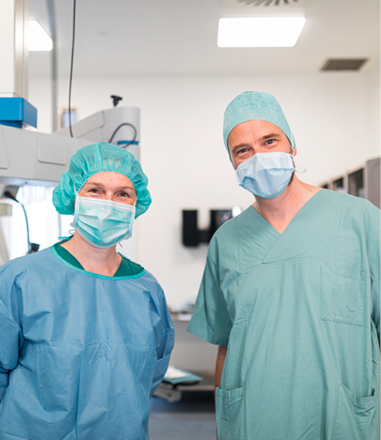Sharing workspace with a Collaborative Robot
In 2018, Ophtec launched two Precizon Presbyopic IOL models: Precizon Presbyopic NVA and Precizon Presbyopic Toric. Both IOLs offer the ophthalmologists the opportunity to choose the best model for their patients. To be able to help the growing number of patients around the globe, innovation of the production process was required. Ophtec’s experts in the field: production engineers Bert Bodewes and Erwin Kerstholt, set up a production line with a collaborative robot for the production of the two Precizon Presbyopic IOL models.
Producing IOLS with a complex geometry
Carving the complex geometry of a presbyopic IOL with Continuous Transitional Focus optic, takes time. Without this collaborative robot, the operator would have to interrupt his work every few minutes, to start the production of a new lens.
Erwin Kerstholt: “The advantage of this robot is that it can produce lenses 24-7. Only one action of the operator is needed. It keeps running at night and in the weekend. To be able to help the growing number of patients around the globe, this robot simply was a must for us.”
Collaborating with a robot
The complete production process of the Precizon Presbyopic IOL remains a craft: a total of four people are involved.
Bert Bodewes: “This collaborative robot is force-limited, which means it does not have to run behind a shield. Operators can freely move around the robot and the robot can easily be stopped by touching it. A big advantage comparing to other robots.”
Future IOL models: no more big batches
In the future, this robot enables Ophtec to introduce new Precizon IOL models and it opens up a whole new area of IOL customization with personalized optics. The production program can automatically change many times a day, depending on the demand. This would give ophthalmologists the opportunity to offer patients a customized solution.
Erwin Kerstholt: “We had to process changes manually. Now, the Robot recognizes the product through a bar code and it automatically runs the right program. This enables us to produce small batches, which means we can produce on a patient-design level.”
Regulatory Challenges
Next-generation robotics provide the opportunity to modify the production process, which enables Ophtec to produce on a patient-design level in the future. Current regulatory practice makes gaining approval for a customized approach difficult. Still, pursuing such innovation is in line with Ophtec’s vision to offer clinically innovative ophthalmic products to patients and doctors, with a focus on perfection.


%20magazine/2024/OTR%202024%20-%20Sjoerd%20blog_header_800x450.jpg)

